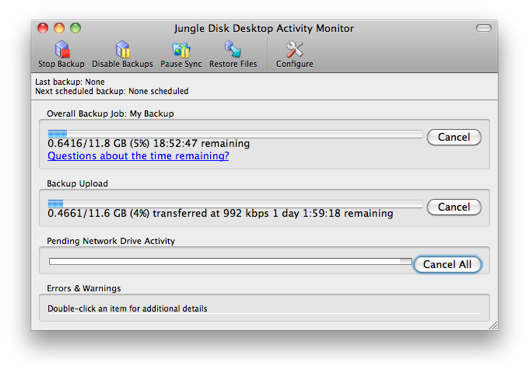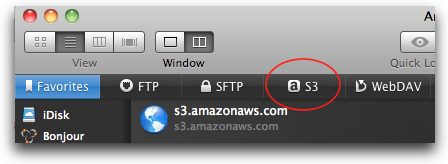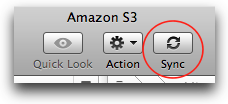S3 sirens me deeper into the cloud
Lately, my head’s been in the clouds. First, I created an Amazon S3 account so that I could use a nifty WordPress plugin called Updraft to back up PE to the cloud.1 Works great.
And then of course, my mind started wondering what other data I could convect up there.
Dropbox versus S3
Until recently, Dropbox was the only side of my backup workflow that touched the cloud. I love Dropbox for many, many reasons, but I’ve never seen it as the ideal place to park what I consider “static data.” To me, Dropbox is a place primarily for
- Working data: documents, spreadsheets, and text files.
- Sync-oriented data: application settings and other things that get accessed from iOS and multiple computers.
This is an oversimplification of how I use Dropbox, but it’ll do.
Main point: Dropbox isn’t the place for large chunks of data like my Aperture 3 photo library, but my new Amazon S3 account seemed like the ideal cumulonimbus. Not only does S3 offer unlimited storage capacity, it’s dirt cheap:
- The first TB of storage is only 14 cents per GB per month
- The first TB costs 10 cents per GB to transfer in
- There are no minimum fees.
Basically, you pay for what you use, and you’re not paying a lot -- as long as it stays fairly still.2 You’ll have to look at how much data you’ll be parking there and decide whether it’s cheaper than a tierd-price option like Mozy or a fixed-price option like Backblaze.3
(Data prices aren’t the whole story here, however, so be sure to look into the full feature set of any service you choose.)
Syncing to S3
Getting data into your S3 buckets isn’t hard. Just sign into the AWS console, and upload. If you have lots of data to upload, though, you’ll want to figure out how to sync so that, down the road, you don’t have to re-copy data that hasn’t changed.
A couple of options here:
- Transmit
- Jungle Disk
Transmit
Transmit is an FTP client that supports Amazon S3. It also happens to be my favorite FTP client. It’s beautifully designed and very reliable.
Not only can Transmit connect to my S3 account making it look and feel like an FTP server, it can mount S3 buckets as volumes so they appear right in the Finder.4
Best of all, I can use Transmit’s handy sync utility to mirror folders.
Jungle Disk
Jungle Disk offers several different service levels for businesses and individuals who want to back up to the cloud. It can also be used as an S3 client. I’m using their Desktop edition, which costs $3 per month.
I won’t discuss every thing that Jungle Disk can do, but for me, the most appealing justification for the extra $3 per month is its highly intelligent sync ability. After doing my initial upload, I decided to reorganize my S3 buckets and folders a bit. Jungle Disk flawlessly found my data on the very next sync and only uploaded new data.
You can also configure synced backup plans in advance with Jungle Disk, and while it might not win any design awards, the Activity Monitor is very useful for monitoring the progress of backups.

Like Transmit, Jungle Disk can mount S3 buckets as volumes, which appear in the Finder. Take a look at their site for more details on all that Jungle Disk can do.
My backup workflow is a little better now
Right now, I’m not interested in putting every scrap of data I own in the cloud. I was already backing up all of my data to external hard drives.
But it’s really nice to know that my photos, in particular, are all but immune to loss now. I may outgrow S3’s variable pricing at some point, but it seems like just the right solution for now.
If you have a chunk of static, bulk data that, if you lost, you’d lose your mind as well, consider giving Amazon’s S3 service a try.
- Hat tip to Mr. Brett Terpstra for turning me on to this one. ↩
- Actually, right now it’s really cheap. The first year is free for new accounts as of the date this post was published. ↩
- Just multiply the number of GBs you’ll store by $0.14. As long as the number is less than other fixed-price options, S3 is the better choice. 50 GB is a decent, general break-even point. ↩
- Yes, that means you can save files directly to an S3 bucket right from any Mac app. It works even if Transmit isn’t currently running. ↩


